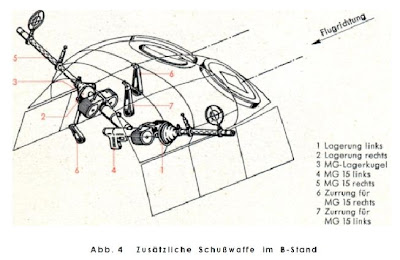As with their new 1:32 kits, the new tool Revell Junkers Ju 88 A-4
Schnellbomber in the one true scale appears to set new standards. The box itself is huge with its striking - albeit apparently spurious- KG 30 artwork, presumably based on the 'celebrated' Piraeus raid which took place on the evening of 6 April 1941 as described in his memoir by the
Staffelkapitän of 7./ KG 30 'Hajo' Herrmann flying 4D+AR - a little early for a Mediterranean A-4 perhaps. So much for the box art. The kit itself is impressive - when Revell state that their new Ju 88 features a 'super-detailed' cockpit and an extensively equipped interior they are not exaggerating - no fewer than 13 of the 50-odd build stages are devoted to the cockpit and forward fuselage, including a detailed and 'poseable' C-Stand ventral Bola. The side panel detail, the consoles and radio gear are all superb and even feature various levers moulded perfectly in situ. Rudder pedals are also separate parts -must be a first in this scale- and a decent representation of the compass also feature. A nicely-detailed bombsight extends down to the cupola bomb aiming window. Rather than just include 'generic' machine guns an attempt has been made to accurately represent the various different MGs in the cockpit area, ie MG 15/17, MG 81 and MG 81Z, although the sights are solid plastic. Anything else in this scale would have been totally impractical. Total parts count is not given anywhere on or in the box - I've seen figures ranging from 125 to 140, although the ordnance is numbered in the 230s. There are nearly 100 items on the decal sheet, including the side window angle of attack sight lines. There are also decals for the external engine instrument clusters on both engines. Featuring separate control surfaces and landing flaps and perfectly recessed panel lines, this kit is graded at Series 4 level complexity. The clear parts are bagged separately and look first class. The rotating LL-K81 Bola MG mounts for the rearward firing MGs are separate clear parts. A couple of low spots, more personal bugbears - the main wheels are moulded in two halves and the KG 30 decal option, as mentioned above, appears to be fictitious, apparently based on a 30-year old John Weal profile - or perhaps on some undocumented personal recollection. Having hunted through my references (including the impressive AirDoc monograph and the three recent Kagero volumes) and researched some of Kagero's decal subjects I can tell you that I failed to find anything quite this colourful. More to the point there were few if any A-4s in the Balkan/Crete/Med theatre. In the first of the Ju 88 Kagero monographs there are decals for a nice KG 30 machine with areas of yellow on the airframe - this is an A-5 coded 4D+VH. The other kit decal option is a sand-brown LG 1 machine. Click on the images for a closer view and carry on scrolling down for some reference images of the forward fuselage and selected cockpit handbook photos..not all of the followng are A-4s of course; as John McIllmurray at
AIMS - the Ju 88 modelling site - pointed out recently it is the engine that makes the difference to the type - other features changed during production for example you can have an A-5 with A-4 canopy or you can have an A-4 with earlier A-5 rudder. You can have an A-4 with Ju 88 S/T nose cone - it goes on and on.
The images will however be very useful when it comes to masking the extensive cockpit glazing, a job which has taken me the best part of a day's session...
Test shot build photographed by Rowan Gough at Telford.
My build is underway here
http://falkeeinsmodel.blogspot.com/2011/12/new-tool-revell-junkers-ju-88-4-04672.html
The completed model is here
http://falkeeins.blogspot.co.uk/2013/02/172-scale-revell-junkers-ju-88-4-new.html
Two views of an early A-variant cockpit showing the instrument panel and forward-firing MG (above) and the pilot's seat and control column (below)
Note the additional defensive side-ways firing MG 15 in the upper rear cockpit roof glazing in the picture above, the so-called
B-Stand Zusätzliche Schußwaffe and two handbook images showing the staggered lay out of these
supplementary twin drum MG 15s in the B-Stand interior position operated by the
Beobachter (observer) in this view looking forward.
Two views above of an A-4 having its inboard wing tanks refueled. A good view of the rotating LL-K81 MG mounts
Ju 88 A-4 W.Nr. unknown "9K+V?", KG 51, Eastern Front, Spring 1942.
Click on the label links below for more Ju 88 and Ju 88 model posts including a review of the Hasegawa Junkers Ju 88 G nightfighter kits



































































